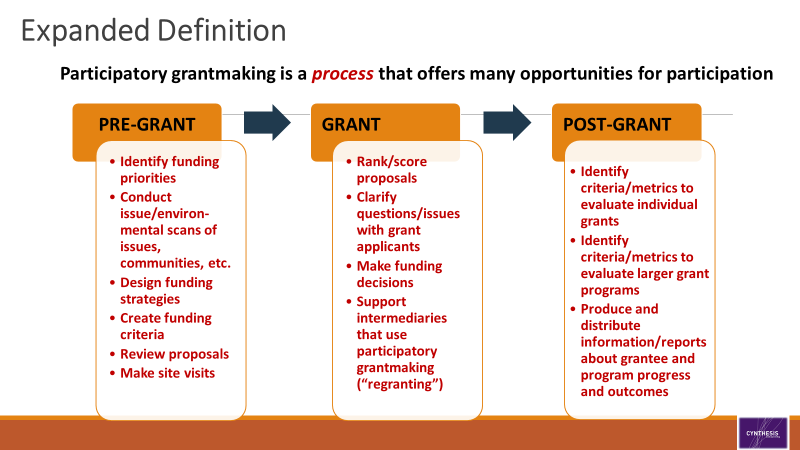Takeaways Blog on Participatory Grantmaking

This blog summarizes key notes from our June Fundamentals of Family Philanthropy webinar.
Many family-led philanthropies are successfully using a participatory grantmaking approach by engaging community members in their decision-making. And, for many philanthropic families, participatory grantmaking is an emerging practice.
In the National Center for Family Philanthropy’s recent webinar, Nwamaka Agbo, Monica George, Cynthia Gibson, Ambar Cristina Hanson, and Leslie Ramyk explored several critical questions:
- What is participatory grantmaking, and why is it an important emerging practice in the field?
- How and when is participatory grantmaking best leveraged within a family philanthropy effort? What are strategies for success and common challenges?
- What are the various considerations giving families should understand as they employ participatory grantmaking within their philanthropy?
Here are important takeaways from the conversation.
What is participatory grantmaking?
Participatory grantmaking shares decision-making power with the communities a funder aims to support, by centering community voices in the process. The definition of participatory grantmaking shared in the webinar, views grantmaking as more than writing checks or making grant decisions. Rather, it is a process, grounded in relationships, that has three general components: what happens before the grant is awarded, what happens when making the grant, and what happens after the grant.

Slide excerpted from “Participatory Grantmaking” presentation by Cynthia Gibson
Why participatory grantmaking?
Most philanthropic families do not have direct, lived-experience the issues they are trying to address. By including community members, who are closest to community conditions and needs, philanthropic families can lean on their expertise to make informed choices that lead more effective results. This approach is not about outsourcing grantmaking, but rather intentionally engaging subject matter experts in the decision-making process at all stages of pre- and post-grant. If traditional practices have not resulted in the level of impact and transformation that you hoped to see, then it is time to try something different. Family philanthropy is well-suited to adopt innovative approaches that share power and center community voices.
Develop a community engagement process
Inviting community members onto your grantmaking committees is an important step, but, in order to develop a truly participatory process, communities need to be engaged early in the decision-making timeline. For example, you can create focus groups with community members that can help determine the priorities of a particular program area to ensure the program is meeting community needs.
Engage board members throughout the participatory grantmaking process
Funders who want to begin a participatory grantmaking program need to ensure that they’re not inviting community members to a “table that’s already been set.” Board members must be ready to embrace the approach and listen to the expertise of community members. When you are making the transition to a participatory grantmaking approach, panelists stressed how important it is to engage board members from the beginning of the process. It is critical to get board members in the same space with community leaders, so that board members can understand the depth of knowledge and expertise of those leaders. This will not only provide learning opportunities for board members, but also begin to develop a trusting relationship between the board and community. In one instance, these conversations led to a family board member advocating that a grant committee become majority community members and minority family members.
Participatory grantmaking often leads to moving away from traditional processes
Relationships between foundation staff and board with community members must be centered on trust. Building trusting relationships with community members allows them to challenge foundation leaders to think deeper and more intentionally about other strategies that the foundation may not have yet considered. These relationships help philanthropic families better understand the necessary impacts that are needed to really transform communities.
When you ground your grantmaking in relationships with community partners and center decision-making around what you hear from your community partners, you may find yourself reconsidering other processes as well. With participatory grantmaking, the focus becomes what is best for grantees and the community, rather than internal processes of the foundation.
To learn more, the recording and transcript of “Participatory Grantmaking” are available exclusively to NCFP Friends of the Family and Partner Subscribers.
Daria Teutonico is a program director at NCFP.
